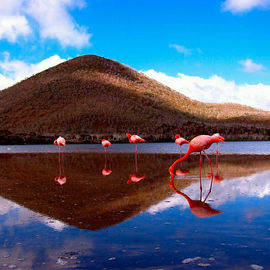
GALAPAGOS
Dreamworthy Destinations
600 miles off the coast of Ecuador lies an archipelago of islands so remote, many of the species are endemic to the islands. The lack of natural predators on the Galapagos Islands gives the wildlife a sense of security and visitors are rewarded with friendly and playful sea lions, marine iguanas, marine turtles, and penguins who will happily interact with you. Don’t be surprised to find yourself face to face with a sea lion while you are snorkeling around many of these incredible islands.
The Galapagos Islands were the first world heritage site created by UNESCO in 1978 and the Galapagos Marine Reserve was created in 1998. The islands are well-known as the center of Charles Darwin’s theory of “The Origin of the Species”. Darwin spent time in the Galapagos, as part of a five-year journey, studying the natural flora and fauna of the islands before he published his groundbreaking book, “The Origin of the Species” in 1859.
Thanks to its geographical position north of the Equator, the Galapagos Islands stays warm all year round. The islands have two distinctive seasons: dry and rainy. The dry season brings cooler temperatures from June-November and the rainy season between December to April brings warmer temperatures.



The best way to see the Galapagos Islands is by a small ship expedition where you cruise around the archipelago consisting of approximately 19 islands. Each of the islands possesses its own wildlife and unique landscapes – some are extinct volcano craters inhabited by endemic bird species, while others are sandy beaches where the sea lions bask in the sun or sally lightfoot crabs dig their way through the sand.
Most ships leave from Baltra, the main port of the Galapagos Islands. They alternate between different routes that last 7 days, traveling either northward or southward. There are stringent laws about the itineraries which are governed by the Galapagos National Park. The routes are created to reduce crowds and environmental stress, not only on the animals but also the flora, fauna, and coral as well.
It’s important to know what you want to see before you go, as not all wildlife can be found on each island. So, if you have your heart set on seeing the red cormorant or the waved albatross, it’s crucial to know which itinerary will allow you to see these species.
FAQs
-
When is the best time to go?The Galapagos Islands can be visited all year-round, but there are 2 main seasons: There is the dry season from June - November which has cooler temperatures reaching 75F. It is also the busiest season when many families visit on a summer vacation. The rainy season from December - May has warmer temperatures reaching 85F. This season naturally has more rain, usually in the morning, then the sun breaks out in the afternoon. Some say the dry season is better for spotting wildlife. When the Humboldt current passes through, it provides a better chance of seeing more variety of marine life such as hammerhead sharks. You may even get to see whale sharks in some remote parts of the Galapagos Islands.
-
How do I get there?Most trips, whether by land or sea, will start in either Guayaquil or Quito, Ecuador. Whether you find your own airfare there or include it as part of a package, the operator will usually include the flight from either Quito/Guayaquil to Baltra, where the largest percentage of tours and cruises depart from. There are only 3-4 islands that are inhabited and Baltra is the main island for residents, tourism, and commerce.
-
Which cruise lines visit the Galapagos?The Galapagos National Park has strict tourism laws designed to keep the wildlife safe and to protect the fragile islands and marine life from over-tourism. All cruise companies must meet high standards to operate in the Galapagos. You won’t find 3,000 passenger fun ships in this corner of the world. Highly specialized cruise companies operate a fleet of expedition vessels with no more than 100 passengers on board at a time. There are many other types of travel companies that visit the Galapagos Islands. Some will do a land-based vacation with day trips to the surrounding islands, others will do a combination of hotel and cruise. Doing your research is important to plan the right trip for you and your travel needs.
-
What is a typical day like on a Galapagos cruise?The experience onboard an expedition vessel is nothing like a Caribbean cruise. A typical day could look something like this: Get up bright and early Have breakfast Go on a zodiac landing to one of the islands for a nature walk An expedition leader will give a brief overview of the island and show you the many different species of birds and other wildlife. Many cruises even have photographers who will share their knowledge and help you take amazing photos, even with an iPhone. Lunch Back on the Zodiac for an afternoon of snorkeling or other water sports Dinner Evening lecture, video or daily recap on the events and an overview of what to expect the following day
-
Do I need a visa?American and Canadian citizens do not require a visa. To enter the National Park you need to pay a fee, but this is usually included in your package while booking an expedition.





